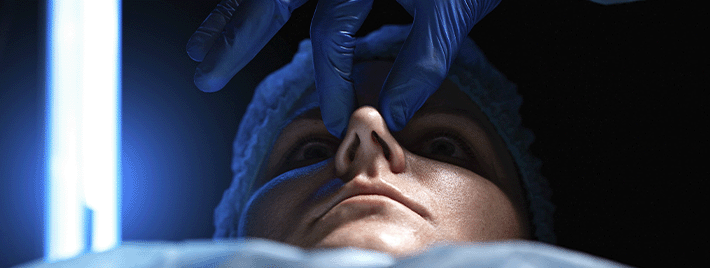Post Date: 2/11/2023

Rhinoplasty, a surgical procedure that involves reshaping the nose to improve its appearance or function, is a cosmetic procedure that can also improve structural abnormalities that may affect breathing. There are two surgical techniques used to reshape the nose: open rhinoplasty and closed rhinoplasty.
An open rhinoplasty involves making an incision across the columella, which is the vertical strip of tissue separating the nostrils. The incision allows the surgeon to lift the skin and soft tissue off the underlying structures of the nose, providing a clear view and access to make any necessary alterations. The surgical outcome is more visible and allows for greater precision and accuracy.
A closed rhinoplasty, also known as endonasal rhinoplasty, involves making all incisions within the nostrils, so no external incisions are visible. This technique is less invasive and leaves no visible scarring, but it can limit the extent of the surgical alterations that can be made and may result in a less predictable outcome.
Open rhinoplasty is a surgical procedure that involves making an incision across the columella (the strip of tissue separating the nostrils) to access the underlying structures of the nose. The procedure is performed under general anesthesia and can take several hours, depending on the extent of the reshaping desired. Several issues are monitored before and during open rhinoplasty.
The patient is given general anesthesia to ensure that they are comfortable and relaxed during the procedure. A small incision is made across the columella, which allows the skin and soft tissue to be lifted off the underlying structures of the nose.
The underlying cartilage and bones of the nose can be reshaped to change the shape and size of the nose. This may involve removing or adding tissue, or reshaping existing structures. If the patient has any structural abnormalities, such as a deviated septum, that are affecting their breathing, the surgeon may make corrections during the procedure.
Closed rhinoplasty, also known as endonasal rhinoplasty, is a surgical procedure that involves making incisions within the nostrils to access the underlying structures of the nose. The procedure is performed under general anesthetic and can take several hours.
The following steps outline a typical closed rhinoplasty operation:
The closed rhinoplasty procedure can yield the best results when performed by a qualified surgeon or ENT specialist. Factors such as the surgeon's experience, the patient's nasal anatomy, and expectations about the outcome of the procedure can also affect the outcome of the operation.
The type of rhinoplasty treatment (open or closed) is determined by several factors, including the patient's anatomy, the desired outcome of the procedure, and the surgeon's expertise and experience.
The patient's anatomy, including the size and shape of their nose and any structural abnormalities, will be considered when determining the type of rhinoplasty treatment. For example, a patient with a complex deformity may require an open rhinoplasty to achieve the desired outcome.
The desired outcome of the procedure, including the extent of reshaping, will also play a role in determining the type of rhinoplasty treatment. For example, a patient who desires only subtle changes to the shape of their nose may be a candidate for a closed rhinoplasty, while a patient who desires more extensive changes may require an open rhinoplasty.
It is important to note that the type of rhinoplasty treatment can also influence the recovery time and potential risks and complications associated with the procedure. The surgeon or ENT will discuss these factors with the patient during the consultation and help determine the best course of action.
A well-proportioned nose can greatly improve the overall balance of facial features and contribute to a more harmonious appearance. Furthermore, correction of any functional abnormalities can greatly improve the quality of life of people with breathing difficulties. All positive results received, helps to significantly increase one's self-confidence and self-esteem.
The success of a rhinoplasty procedure depends on an experienced surgeon, the patient's anatomy, the patient's expectations of the procedure, and similar factors. Therefore, careful selection of a qualified and experienced surgeon or ENT specialist is essential.
Imagine having a nose that is perfectly balanced and proportionate to your face, complements your style, and makes you feel good about yourself. Rhinoplasty can make this a reality and help you look and feel your best.
With the right surgeon and careful planning, rhinoplasty can provide life-changing results that can have a positive impact on your self-confidence and overall well-being. To learn more about rhinoplasty, schedule a consultation with Selçuk İnanlı and his well-equipped medical team today. Start experiencing the benefits of aesthetics and health.